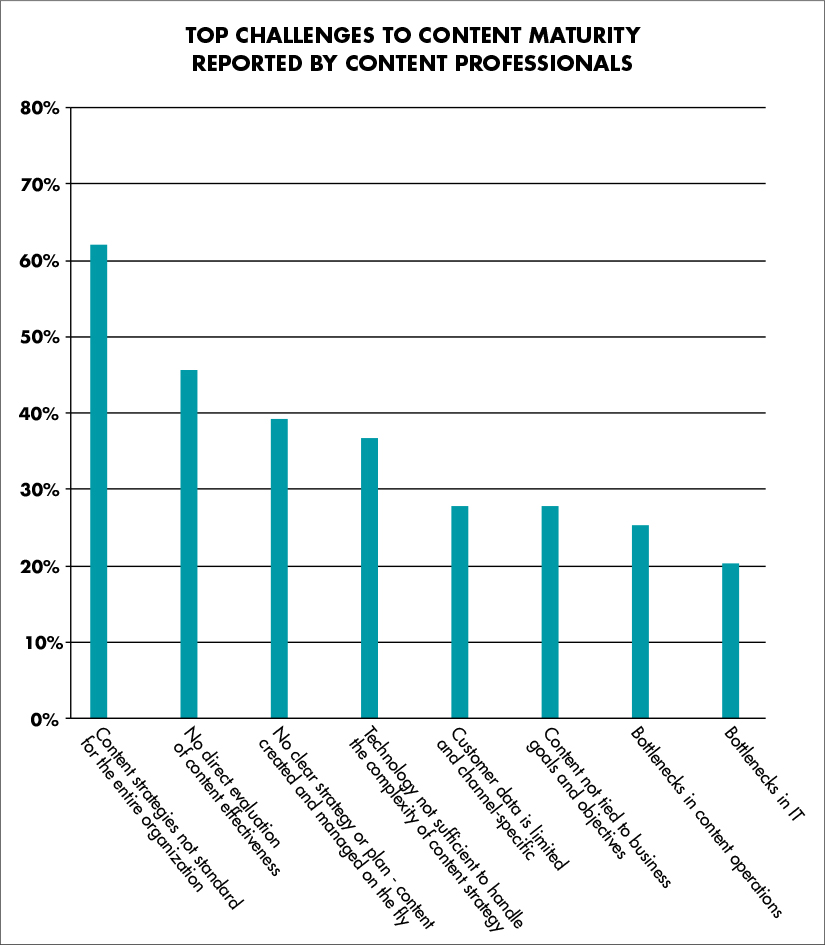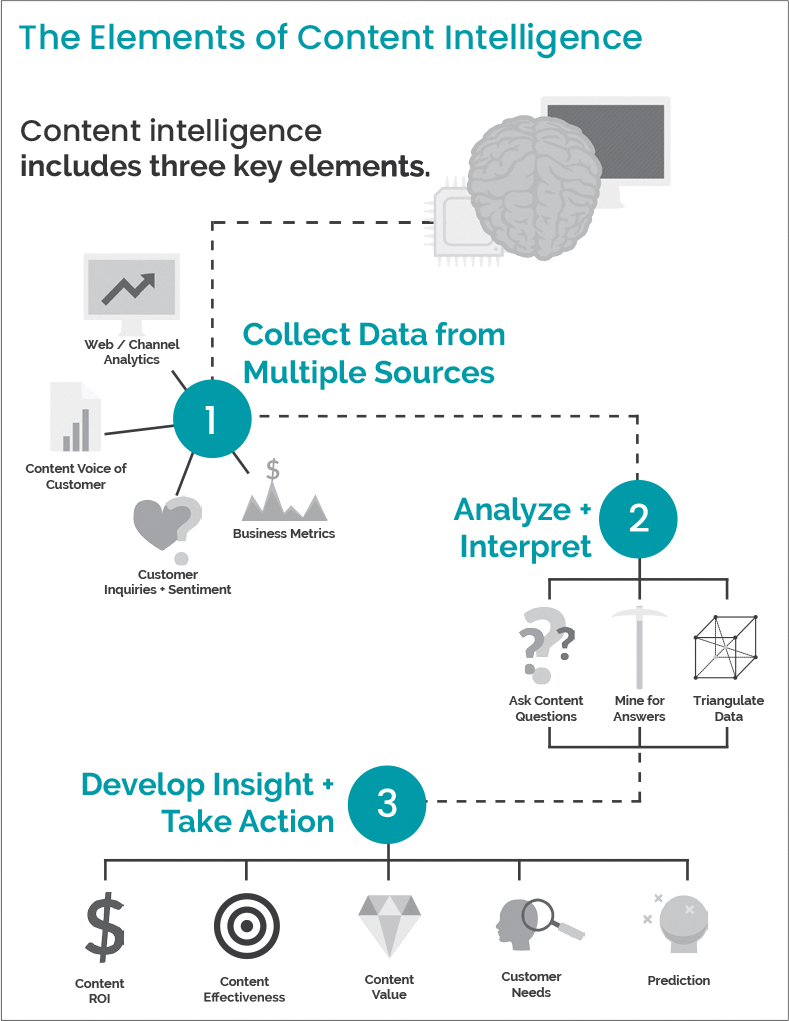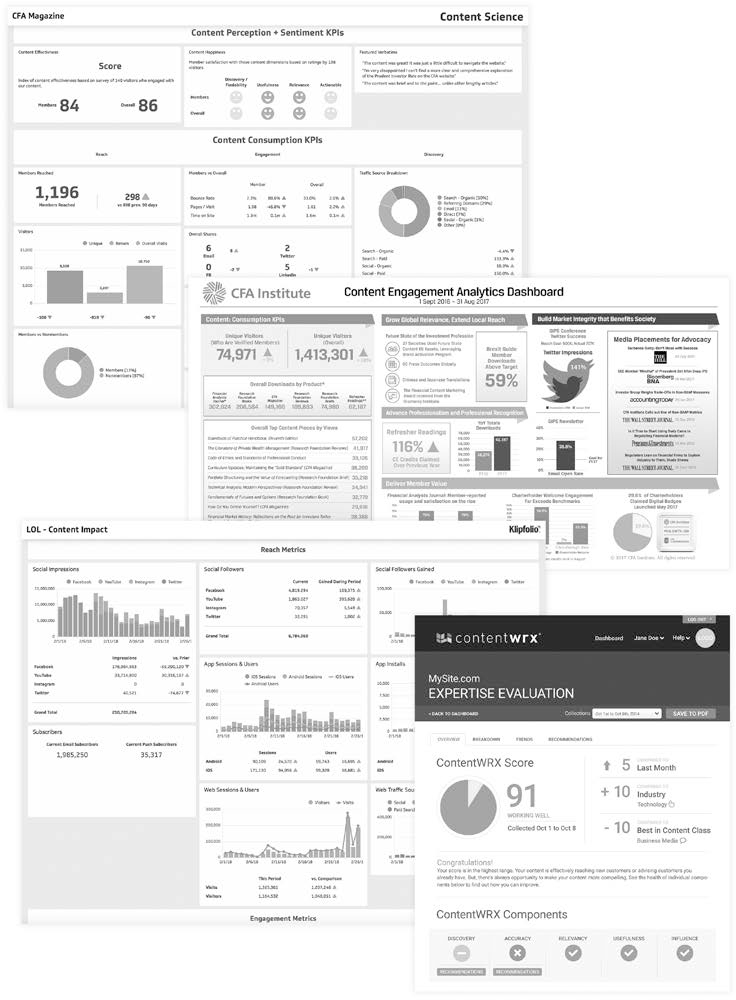8 Set Up a Content Intelligence System
Turn content data into actionable insight.
WHAT GETS MEASURED GETS MANAGED.
—Peter Drucker
REMEMBER: YOUR FOCUS DETERMINES YOUR REALITY.
—Qui-Gon Jinn, Star Wars: The Phantom Menace
Inspired by business intelligence, content intelligence is the term I use to refer to a system of collecting data related to your content and turning it into insight for content decisions and more. Let’s walk through why your company needs content intelligence and the key elements of a content intelligence system.
Why Content Intelligence
Whether you’re skeptical about needing content intelligence yourself or you need to convince someone else, rest assured that many reasons exist to embrace the data side of your content. Allow me to highlight five main reasons.
Make Smarter Content Decisions for Better Business Results
With useful data about your content on tap, you can make higher-quality decisions about content and, ultimately, make the content more effective. Those content decisions might be strategic, such as investing in a new form of content, as REI did when it developed an original documentary series or as Netflix did when it created House of Cards. Or those content decisions might be tactical, such as when Netflix tested the performance of three versions of the art for a movie teaser. Both strategic and tactical content decisions benefit from data.
Show Progress to Motivate Continued Content Innovation
We know from a variety of research that seeing progress motivates people. (For an excellent summary of this research and practical application, I highly recommend The Progress Principle, by Teresa Amabile.) It is difficult, if not impossible, to show content progress without clear data. I like how Ann Marie Gray, vice president of content at ASUG, explains the connection.1
You should always be raising the bar for yourself. Nowadays, everything has become so data-driven, which allows us to see what’s working, what content is driving results—but the value of that is what you do with it.
Similarly, Jung Suh of SAP describes the excitement of having data to inform content decisions.
We are constantly creating and refining our content. With the right tools and processes, this is more exciting than daunting. We can see where our content is falling short, identify gaps, and zero in on emerging opportunities.2
Make Future Content Analysis and Auditing Easier and Integrated with Governance
Often, companies wait until a redesign or until a replatforming or a digital transformation initiative becomes priority before they analyze their content in the way described in Chapter 4. Because content analysis has not happened in years, it’s a big, expensive, slow job. When that analysis is finished, most companies return to “content as usual” and don’t analyze again until they face another significant change. Wouldn’t it make more sense to invest resources in ongoing content intelligence instead? That way, you can handle analysis for the next big change more efficiently, and you can make data part of your content governance.
While director of digital governance at Intel, Scott Rosenberg, nicely explained the role of data in governing content.
As for addressing our content quantity issues, we focused on data. Content creation can certainly be a very personal and emotional topic. We realized that and decided to minimize as much as possible the emotional element by identifying clear, objective criteria to evaluate content against. We’ve learned from previous efforts at governing content that were too focused on just performance data only that we needed to take a multidimensional approach to evaluating content. Instead, in addition to performance data, we looked at strategic alignment to corporate priorities, content ROI, and resource commitments to support. This data-focused and collaborative approach resulted in far fewer escalations and emotional pleas from our stakeholders.3
Gain Insights about your Customers
When customers interact with your content, they leave signals about who they are, what they need, what interests them, and more. Learning more about your customers not only helps with offering the right content for them but can also inform your marketing or sales approach, generate product and feature ideas, or innovate customer service. For example, CFA Institute—a not-for-profit association that credentials investment professionals—learned that prospective entrants into their credentialing program often compared attaining the Chartered Financial Analyst (CFA) credential with attaining an MBA. Consequently, the CFA Institute developed content to help prospects compare the options.
Lay the Foundation for Advanced Content Automation
If you’re thinking about scaling your approach to content, you might be thinking about content automation and how different types of artificial intelligence can help. I like the way you think. We’ll talk more about content automation in Section V, but for now I will note that collecting data about your content helps. A lot.
I’ve covered five main reasons to embrace content intelligence, and you might think of others. Yet Content Science studies have found that even though most content professionals want content intelligence, only the most advanced companies are embracing it (Figure 8.1).

Figure 8.1: The lack of content evaluation and customer data aligned with strategy and goals signals a desire for content intelligence.
I once worked with an enterprise possessing one of the biggest data lakes in the world—a data lake rivaling that of Amazon—yet their content teams had no visibility into the data. The content teams operated in a data desert, making content decisions with no clue about their impact and no way to understand whether they were making progress toward goals. The content teams also lacked evidence about content impact to support their conversations with stakeholders. The content teams often felt powerless when stakeholders insisted on certain content solutions, terminology, or approaches and refused to collaborate. Instead of letting content teams thrive with the data lake, this company made their content teams parched for data-informed decisions, signals of progress, and productive collaboration.
The good news here is that you and your company face a tremendous opportunity to leapfrog most companies’ sophistication with content and data by embracing content intelligence.
The Elements of a Content Intelligence System
The content intelligence approach consists of three main elements, as you can see in Figure 8.2.

Figure 8.2: The elements of a content intelligence system
A content intelligence system collects content-related data from multiple sources, and then analyzes that data to answer questions about content performance and more. Looking at the data through the lens of content is key. Let’s explore each element of content intelligence, starting with getting the data.
Gather Content Data from Multiple Sources
Strive to collect two types of data: behavioral data and perception data.
Behavioral data tells you who your users are and what they do with your content, including how users find it and where they are engaging with it. For example, you might look at web analytics to understand actions that users are taking with your content that provide value to your organization. You may look at your channel analytics, such as phone calls or chat inquiries, to understand how content is supporting your sales and marketing efforts. And you might use business metrics, such as revenue or churn rate, to find large-scale correlations with your content efforts.
Perception data tells you what users think about the content and about your company or your offerings as a result of the content. You can review the substance of email, chat, and phone inquiries. You also can gain insight through polls, surveys, ratings, comments, reviews, and other ways of capturing the voice of the customer. And if your company has a strong social media presence, you can review the sentiment and comments about your content or topics covered by your content.
Of course, data by itself is not inherently valuable to any organization. Your data becomes valuable when you’re determining what’s happening with your content, which leads us to the second element of content intelligence.
Analyze and Interpret the Data
Once you have begun gathering data, establish an approach to analysis and interpretation focused on your content by following three steps:
Ask content questions.
Mine the data for answers.
Triangulate the data.
Each of these three steps requires that you get the right people and processes in place to accomplish them.
Ask Content Questions
Asking the right questions about your content’s performance requires you to define a goal for your content that aligns with your overall business objectives and that supports growth. What are you looking to achieve with this content? You can summarize this goal by completing the sentence, “This content will ________________.”
Diverse types of content have diverse goals. For example, product comparison tools, product pages, and demonstration videos guide customers along the buying journey. Your ultimate goal for this content is to make a sale.
Once you know your content’s end goal, you define how your content can reach that goal. What are the elements of your content’s performance that will add up to the accomplishment of that goal? These are evaluation dimensions and are what you can directly measure. Some examples of these dimensions are:
Reach—the number of customers who use your content, and whether it’s growing
Engagement—how well your content commands your customers’ attention
Perception—how your content influences the way people feel about your company or offerings
Comprehension—how well your content helps your customers understand a topic, issue, or problem
Once you’ve defined the dimensions across which your content needs to succeed, you’re ready to start asking questions about its performance. Determining the right questions will help you understand what data you need to measure. For example, to understand how your content drives engagement, you might ask:
Are our customers regularly returning to the content?
Do our customers read and click our emails?
Are our customers looking at multiple pieces of content on our site?
Are our customers clicking or otherwise engaging with our interactive content?
You can organize your questions in a matrix, such as the sample matrix in Table 8.1.
Table 8.1 A Sample Content Intelligence Matrix
SALES CONTENT |
|
|---|---|
Goal: Increase sales scope and speed by providing useful, compelling content to support customers in their buying journey. |
|
Engagement |
|
Perception |
|
Conversion |
|
After you determine the questions to ask, you can look to the data for answers.
Mine Data for Answers
This step requires you to use the data you’ve gathered to answer the questions you have about your evaluation dimensions. For example, you might approach your questions about your content’s engagement with the following:
Are our customers regularly returning to the content? Use Returning Users from your web analytics platform, as well as the Sessions/User metric.
Do our customers read and click our emails? Use Opens, Clicks, and Click-to-Open Rate from your email marketing platform.
Are our customers looking at multiple pieces of content on our site? Use Bounce Rate and Pages/Session to see how many users view multiple pieces of content and how many total pieces of content are viewed.
Are our customers clicking or otherwise engaging with our interactive content? Create Events with your tag manager to track clicks, time on content, and other forms of engagement with interactive content in your web analytics platform.
You can even update your content intelligence matrix to include the data points that are likely to help you answer the questions.
Once you know exactly which data you need and where to find it, you can cut down your measurement data to the metrics that make the most sense for speaking to your content’s impact. Then, you can review the data for relationships and more.
Triangulate the Data
When you have the data to answer your questions, you can review it further to search for relationships, causations, and influencing factors. For example, if you see spikes or dips in one metric, look for correlations in the activity of a different one.
While working with the American Cancer Society, there was a time when we noticed a sharp dip in engagement with their “Get Involved” content. Their time onsite and pages/visit metrics had decreased considerably, and when we looked at ContentWRX results we saw that perceptions of this content’s findability and usefulness had also dipped.
When you notice a correlation, you can look into potential causes for the results. We looked further at the ContentWRX results and discovered that mobile users reported they were seeing error messages as they tried to sign up for American Cancer Society events. The Society was then able to fix the mobile content and experience.
Finally, explore how to report and visualize the data so you can better see your content’s impact. Consider creating a standardized report or dashboard to make presenting and socializing content performance an easily repeatable task. (See Figure 8.3 for a few examples that Content Science has helped create.)

Figure 8.3: Sample content intelligence dashboards and reports
Develop Insight and Take Action
Once you’re collecting the right data and you have a system for analysis in place, developing insights that inform content decisions comes easily. You can better understand your content’s effectiveness, estimate your return on content investment, and more. We’ll talk more about how to gain insight and take action in Chapters 9 and 10.
References
1 Content Science, “Content Operations and Leadership Study.”
2 Brightedge, “Content Performance Marketing” whitepaper
3 “Intel Addresses Modern Marketing Challenges Through Digital Governance,” Content Science Review https://review.content-science.com/2016/10/intel-addresses-modern-marketing-challenges-through-digital-governance/